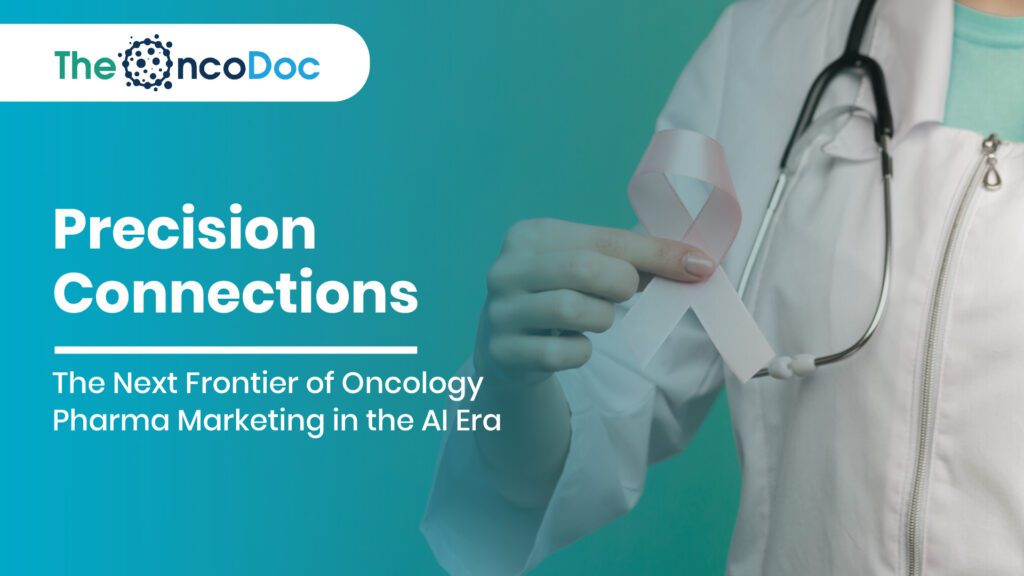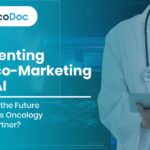Introduction: Oncology Marketing Reimagined
Oncology is at the center of healthcare’s most ambitious transformations. With global cancer cases expected to rise significantly by 2035, the pressure on pharmaceutical companies is not only to innovate in therapies but also to redefine how they engage with patients, caregivers, oncologists, and healthcare systems. Marketing in oncology today is less about persuasion and more about precision, trust, and patient-first outcomes.
Digital disruption, generative AI (Gen AI), and behavioral insights are reshaping the rules of engagement. Campaigns are now evaluated by their ability to increase early screenings, foster accurate disease awareness, and support equitable access, not merely by prescriptions written. This article explores the most relevant and transformative strategies in oncology pharma marketing, building a blueprint for the next decade.
1. Gen AI and Hyper-Personalized Oncology Campaigns
Generative AI has moved from experimentation to becoming the backbone of oncology marketing.
- Content Tailoring at Scale: Gen AI enables pharma companies to instantly create nuanced content for diverse stakeholders, oncologists, general practitioners, patients, and caregivers. For example, a single AI-driven campaign can generate scientific slide decks for oncologists, simplified explainer videos for patients, and social media infographics for community awareness.
- Micro-Segmentation: Instead of broad patient categories, marketers can now target niche subgroups, such as women aged 40–55 in urban India with a family history of breast cancer, delivering personalized reminders for mammograms.
- AI-Assisted MLR Compliance: By flagging potential violations and inconsistencies, Gen AI reduces marketing approval bottlenecks, cutting campaign rollouts from six weeks to under two.
💡 Impact: Gen AI is shifting oncology campaigns from “broad awareness” to “precision awareness,” ensuring that every touchpoint resonates with the right audience at the right time.
2. Patient Empowerment as the Core of Marketing
Patients and caregivers are no longer passive receivers of information, they are active participants in their care journeys.
- Self-Diagnosis Tools: Mobile apps embedded with AI-driven symptom checkers guide patients toward early screening.
- Survivor-Centric Narratives: Campaigns led by survivor voices reduce fear, increase empathy, and build emotional trust between patients and brands.
- Language Inclusivity: Multilingual campaigns (Hindi, Tamil, Bengali, etc.) are critical in India, where 70% of rural patients state they feel disconnected from English-based awareness materials.
Pharma companies that elevate patient empowerment are witnessing not only higher brand affinity but also increased screening participation rates.
3. Engaging General Practitioners for Early Cancer Detection
The primary gatekeepers of oncology care continue to be general practitioners (GPs). Yet, delayed or missed referrals remain a common challenge.
- WhatsApp Micro-CMEs: Condensed medical education courses on cancer warning signs.
- Referral Dashboards: AI-assisted digital tools helping GPs decide when to recommend oncology screening.
- Localized Diagnostic Partnerships: Collaborations with local labs offering discounted screening tests for patients referred by GPs.
💡 Insight: Campaigns that position GPs as co-pilots in early detection strengthen referral pipelines and reduce late-stage diagnoses.
4. Omnichannel Engagement for Oncology Marketing
Patients now traverse multiple touchpoints before making decisions, digital ads, WhatsApp chats, in-clinic kiosks, and community outreach.
Effective omnichannel strategies integrate these into seamless journeys:
- Instagram reels with survivor-led awareness stories.
- Push notifications via mobile apps for screening reminders.
- Interactive kiosks in oncology hospitals explaining therapy pathways.
- Tele-oncology consults bundled with pharma-sponsored awareness campaigns.
Consistency across channels fosters trust and recall, ensuring patients and doctors see pharma brands as partners, not promoters.
5. Behavioral Science as a Marketing Lever
Behavioral nudges are proving more powerful than traditional messaging in oncology awareness.
Examples include:
- Gamified Symptom Quizzes: Engaging patients to self-assess their cancer risk.
- Appointment Commitment Nudges: Text reminders framed as “most people in your area completed their cancer checkup this month.”
- Social Proof Campaigns: Sharing statistics like “70% of women in your district have undergone mammogram screening” to increase participation.
💡 Impact: Behavioral design has shown a 20–30% increase in preventive screening uptake across oncology campaigns.
6. Emotional Storytelling for Trust-Building
Cancer is both clinical and deeply emotional. Survivor voices are now considered the gold standard in campaign storytelling.
- Video Diaries: Documenting real-life recovery journeys.
- Community Sessions: Survivor-led workshops in schools, workplaces, and rural health camps.
- Peer-to-Peer Counseling Platforms: Pharma-backed digital platforms where survivors guide newly diagnosed patients.
Emotional storytelling not only boosts campaign engagement by over 40% but also positions brands as empathetic allies in the fight against cancer.
7. Predictive Marketing Powered by AI
AI is enabling pharma companies to anticipate awareness needs rather than reacting to them.
- Search Data Analysis: Sudden spikes in queries like “lump in throat” can signal the need for micro-campaigns in that geography.
- Social Listening: Detecting harmful myths such as “herbal cures for cancer” and deploying rapid-response factual campaigns.
- Predictive Screening Alerts: AI-driven dashboards helping hospitals prepare for increased diagnostic demand in high-risk regions.
💡 Future Outlook: Predictive analytics will transform oncology pharma marketing into a proactive health intervention tool.
8. Vernacular and Hyperlocal Campaign Strategies
Cancer awareness must be culturally embedded to succeed.
- In Tamil Nadu, breast cancer awareness campaigns in Tamil resonate 3x more than English campaigns.
- In North-East India, oral cancer campaigns delivered via folk music and community radio outperform digital-first approaches.
- Hyperlocal Influencers such as school teachers or local doctors often prove more trusted than national KOLs.
💡 Insight: Hyperlocalization ensures campaigns move beyond “reach” into real relevance and comprehension.
9. Wearables and Digital Health Integration
Wearables like smartwatches and fitness trackers are emerging as silent allies in early oncology awareness.
- Lifestyle Monitoring: Detecting weight loss, irregular heart rates, or poor sleep, common early signs in cancer.
- Integrated Alerts: A patient with anomalies receives nudges like “schedule a screening near you.”
- Pharma Partnerships: Companies linking wearables with their patient support apps to provide customized awareness content.
💡 Impact: Integration with wearables shifts oncology marketing into a continuous engagement model.
10. Redefining Oncology Marketing Metrics
Traditional KPIs like clicks or impressions hold little meaning in oncology. Modern campaigns measure real-world health outcomes.
Key performance metrics include:
- Screenings Booked through campaigns.
- GP Referrals following CME modules.
- Emotional Sentiment (hope, fear, trust) tracked through campaign engagement.
- Survivorship Engagement post-treatment.
💡 Insight: By linking marketing directly to health-first outcomes, pharma companies gain credibility and trust.
11. Digital Communities and Post-Treatment Engagement
Beyond diagnosis and treatment, pharma brands are building virtual communities for survivors and caregivers.
- Webinars with Oncologists: Live Q&A sessions on recovery.
- Peer Clubs: Survivor-to-patient mentoring networks.
- Wellness Programs: Nutrition and mental health modules delivered via branded apps.
This holistic approach ensures patients remain connected to the brand even beyond treatment cycles.
12. The Future of Oncology Pharma Marketing
The next decade of oncology marketing will be defined by three imperatives:
- Predictive Precision: Campaigns that pre-empt disease patterns.
- Digital Empathy: Messages that blend scientific accuracy with human connection.
- Sustainable Collaboration: Partnerships across governments, NGOs, and tech companies to democratize access.
💡 Vision: Oncology pharma marketing will no longer be defined by how much it sells, but by how effectively it helps societies detect cancer early, access care equitably, and foster survivorship.
13. Virtual Reality (VR) and Augmented Reality (AR) in Patient and Physician Education
While AR/VR has made significant strides in medical training, its role in oncology pharma marketing is just beginning to shine. These technologies allow pharma companies to simplify highly complex treatment pathways into visual, interactive experiences.
- Patient Treatment Visualization: A newly diagnosed patient can “walk through” a VR simulation showing how immunotherapy works inside their body, replacing fear with understanding.
- Physician-Centric Engagement: AR-based medical education enables oncologists to visualize drug mechanisms in 3D, leading to stronger recall and brand association.
- Pharma-Led Immersive Campaigns: At awareness camps, VR booths can demonstrate how early detection improves survival rates, encouraging screening participation.
💡 Impact: Studies show that immersive visualization increases patient recall by 65% compared to traditional brochures. In oncology, where trust and comprehension are critical, VR/AR bridges the gap between science and human understanding.
14. Ethical AI and Transparent Marketing
As AI-driven campaigns dominate oncology marketing, ethical concerns and transparency are emerging as decisive differentiators for brands. Patients and doctors alike are questioning: How is my data being used?
- Transparent Disclosures: Pharma companies must openly state how patient engagement data is collected and applied, building long-term trust.
- Bias-Free AI Models: Algorithms must be designed to avoid under-representing rural populations or minority groups in cancer awareness campaigns.
- Responsible Messaging: Ensuring AI-driven personalization doesn’t cross into manipulation, for instance, avoiding exaggerated emotional triggers that exploit patient fears.
💡 Future Vision: Oncology pharma marketing will soon include “AI Ethics Scores” as a trust-building KPI, where companies highlight their compliance with ethical standards in campaigns.
15. Real-World Evidence (RWE) as a Marketing Asset
Real-world evidence is no longer confined to regulatory submissions; it is becoming a powerful marketing tool in oncology.
- Localized Data Stories: Sharing real-world outcomes from local hospitals (e.g., survival improvement rates with targeted therapies) resonates more with oncologists than global trial data alone.
- Patient Advocacy: RWE reassures families regarding treatment efficacy outside of clinical trials when it is given in patient-friendly formats (infographics, brief videos).
- Dynamic Campaigns: RWE dashboards can be integrated into mobile apps, allowing oncologists to track and validate real-time benefits of a therapy in their region.
💡 Insight: RWE-driven campaigns align with the demand for evidence-backed decisions, turning pharma marketers into data educators rather than product promoters.
16. Sustainability and Green Pharma Marketing
In 2025, sustainability is a key distinction in healthcare marketing and is no longer a business afterthought. Oncology patients and caregivers increasingly prefer brands that demonstrate a commitment to environmental and social responsibility.
- Eco-Friendly Campaign Materials: Replacing printed flyers with digital QR-based content to reduce paper waste.
- Sustainable Partnerships: Collaborating with NGOs that focus on both cancer awareness and community environmental health.
- Patient Programs with Green Incentives: For example, rewarding participation in screening drives with eco-friendly kits or tree-planting contributions.
💡 Impact: Surveys reveal that 62% of patients trust pharma brands more when they integrate sustainability into their awareness initiatives. This creates a dual impact: building healthcare awareness while reinforcing environmental consciousness.
17. Precision Access Campaigns: Tackling Inequity in Oncology
Cancer care inequity remains one of the most pressing challenges globally. Pharma companies are now launching precision access marketing campaigns designed to bridge socioeconomic and geographical gaps.
· Tiered Outreach: Marketing campaigns are segmented to maximize reach across diverse populations. For instance, AI-driven digital campaigns are deployed for urban audiences, while radio, community influencers, and traditional storytelling are used to connect with rural and low-tech populations.
· Affordable Access: Pharma companies are increasingly focused on improving access to care. This includes sponsoring or co-sponsoring subsidized cancer screening campaigns for specific communities, such as providing affordable mammograms or oral cancer checks in low-income areas.
· Equity Measurement: To ensure that marketing efforts are truly inclusive, brands are using equity dashboards. These analytical tools track campaign effectiveness across various demographics and income levels, allowing companies to measure and refine their strategies to avoid exclusively targeting urban, high-income groups.
📊 Example: A precision access initiative in India showed that when campaigns integrated mobile van screenings + WhatsApp reminders, rural participation in oral cancer screening increased by 40% within six months.
💡 Insight: Equity-driven marketing is not charity, it’s future-proofing oncology brands, as healthcare ecosystems increasingly value inclusivity and patient reach across every socioeconomic segment.
Conclusion: Building a Patient-First, Ethical, and Sustainable Future
Oncology pharma marketing is evolving into a multi-dimensional discipline where technology, empathy, evidence, and equity intersect. With the expansion into VR/AR, ethical AI, real-world evidence storytelling, sustainability, and equitable access, the marketing playbook is becoming richer, deeper, and more human-centered.
The future will belong to pharma brands that not only innovate in therapies but also innovate in trust, through transparency, cultural sensitivity, measurable outcomes, and continuous patient engagement.
💡 Final Thought: Oncology marketing in the AI era is not just about saving lives, it is about empowering them, equally and ethically.
The Oncodoc team is a group of passionate healthcare and marketing professionals dedicated to delivering accurate, engaging, and impactful content. With expertise across medical research, digital strategy, and clinical communication, the team focuses on empowering healthcare professionals and patients alike. Through evidence-based insights and innovative storytelling, Hidoc aims to bridge the gap between medicine and digital engagement, promoting wellness and informed decision-making.



